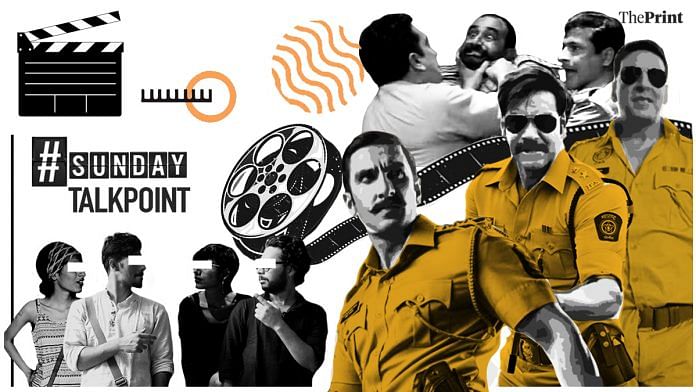Social media users have equated Telangana Police’s action in the ‘Hyderabad encounter’ with those of heroes in Indian ‘formula’ films like Singham, Simmba, Dabangg, Aagadu and so on. Such movies often project mob justice as virtuous and celebrate police officers taking the law into their own hands.
ThePrint asks: Do Indian movies glorify and normalise mob justice?
Hyderabad ‘encounter’ shows we feel satisfaction when our desire for blood is fulfilled, even if only on screen
 Samira Sood
Samira Sood
Associate Editor, ThePrint
Yes, Indian movies certainly normalise mob justice. Andha Kanoon (1983), Ghayal (1990), Dabangg (2010), Singham (2011), Simmba (2018), the list is endless. Even Rang De Basanti (2006) and A Wednesday (2008), though more thoughtful and nuanced than some of the potboilers listed above, did ultimately give into the vigilante trope. And it’s easy to understand why Indian filmmakers do this.
The recent Hyderabad ‘encounter’ has shown that we, as a society, have a truly warped sense of justice, are dismissive of the rule of law and feel deep satisfaction when our desire for blood is fulfilled, even if only on screen. Bollywood clearly figured this out early on.
Moreover, it is far sexier and more entertaining to show people taking the law into their own hands and emerging victorious than it is to show the slow, tedious process of actually dismantling problems (like misogyny) and investing time and resources in judicial reform.
But in a country like India, where Bollywood is influential even if we don’t like to admit it, filmmakers do need to approach their craft with a better sense of responsibility.
Filmmakers often say that they are merely portraying reality as an excuse for their shoddy and questionable movies, but what they don’t seem to consider is that there is a difference between portrayal and glorification.
It is unfortunate that as long as lawmakers like Jaya Bachchan keep advocating medieval-era mob lynching, and social media and its bloodthirsty keyboard warriors keep drowning out every voice of reason and sanity, Bollywood will continue to have its excuse.
It’s foolish to assume that Indian films are the cause of societal problems like mob justice
 Srijan Shukla
Srijan Shukla
Reporter, ThePrint
There is a bit of a catch-22 logic here. Do Indian films propagate mob justice or are they simply depicting fantastical solutions to the issue of the country’s damaged criminal justice system?
As filmmaker Dibakar Banerjee once argued, the life of an average Indian isn’t all that great. It’s full of unnecessary everyday struggles. And dealing with the snail-like pace of both the police and the courts is one of them.
The Indian state doesn’t make life easy for the citizens, so popular cinema tries to find solutions to apparently unsolvable problems. They adopt a cut-to-the-chase narration style by creating a make-believe world where ‘encounter killings’ are heroic acts. In the face of a damaged legal system, films with such content give people instant gratification. It makes them less angry.
Although it’s hard to argue that movies such as Singham and Ab Tak Chhappan don’t normalise extrajudicial killings, it’s a mug’s game to think Indian films are the cause of the problem.
People are celebrating the ‘Hyderabad encounter’ because they are convinced that justice won’t prevail. And that’s exactly the case with most of these ‘cop’ movies. They all depict encounter killings as a tool of last resort.
We can choose to either keep outraging over which films explore such content or outrage a little more and force lawmakers to enact stricter rape laws. But the latter still won’t solve anything. We need to begin by increasing the state capacity of both the police and the judiciary.
The likes of Dabangg show how Indian films mint money by glorifying mob justice, violence
 Unnati Sharma
Unnati Sharma
Journalist, ThePrint
As the Dabangg 3 trailer starts, Salman Khan is heard calling himself “police wala gunda” and thrashing goons. It has garnered more than 49 million views and 1.6 million likes since its release on 23 October. The Dabangg film franchise has been glorifying mob justice right from its first instalment.
This speaks volumes about how Indian movies manage to fetch numbers at the box office by exalting mob justice and violence. Cinema has the power to influence and capture the imagination of viewers, so filmmakers should responsibly choose what content they use in their films.
The idea of vigilantism has been used across the Indian film industry. The hero takes pride in saving ‘society’ or a ‘girl’s honour’ by teaching the goons a lesson all by himself. But it is not only the commercial masala films that use this concept. Some thoughtful films like Rang De Basanti have regrettably also used the concept of ‘instant justice’ and rebellion while neglecting due process of law. This legitimises the idea that taking the law into your own hands is righteous.
This is not to take away credit from other films like Shahid and Pinjar, which have dealt with the idea of mob justice, but sensitively. Having said that, I still strongly believe that cinema cannot be an easy excuse to evade our responsibilities as a society towards protecting the rule of law.
Indian films don’t glorify mob violence. They lack logic at times but it is almost innocuous entertainment
 Nikhil Hajirnis
Nikhil Hajirnis
Chief Producer, ThePrint
A memorable one-liner from Sholay goes thus “Kyunki loha lohe ko kaatata hai (iron cuts iron)…”.
The dialogue is delivered by Thakur to convey that the villain can only be defeated by the two protagonists, who are criminals can only ultimately finish off the villain. I doubt Indian society will see a low where victims have to arrange for their own means of justice but films have always toyed with the idea of the public’s quest for justice. Even so, movies have rarely influenced society so deeply as to normalise mob justice.
Movies like Sholay, Singham or Simmba have shown that it is mainly the central character that overpowers the villain against the backdrop of a fictional Indian society set-up.
While action does provide a heavy dose of entertainment, one must note that it merely shows the illusory physical strength of the protagonist that should not be taken at face value. He or she definitely inspires people to fight for justice but films like Gangaajal also caution people against mob justice and its consequences.
So, I do not think that Indian films glorify mob violence. They certainly lack logic at times but it is almost innocuous entertainment that should not be taken too seriously.
Also read: Another culprit must share the blame for Hyderabad encounter – Indian media
By Kairvy Grewal, journalist at ThePrint




People cannot digest the fact such hard core criminals being served mutton and chicken biryani for decades in the name of Judicial process. Take for example Nibhaya case. The message gone to the public is so discouraging that they were expecting this case too going in that direction!!!
Dear Print, The Moderator needs to be as prompt as I am prolific.
Not much of a movie goer, have not seen most of the films listed in the column. In a darkened auditorium, we know that what we see is part fiction, part fantasy. If complex problems can be solved by Dirty Harry rolling up his sleeves, what is not to like. 2. However, as far as the Hyderabad event is concerned, felt deeply gratified. The best possible outcome in the circumstances. Almost certain that the state’s Chief Executive gave his consent. 3. Recall Dr Singh’s timorous, Theek Hai ? after recording a TV appearance, post Nirbhaya. There is an ululating fury in the country over women’s safety. Not a time to say, Law and order is a state subject. People expect their daughters to be safe. A government will be judged very harshly if it fails to deliver. KCR understood this.